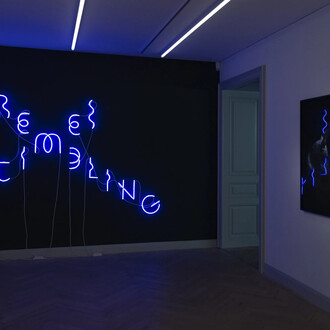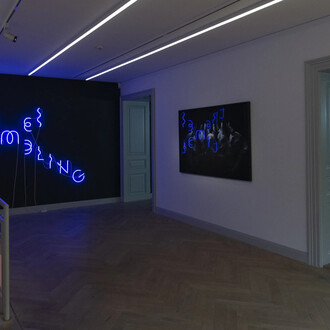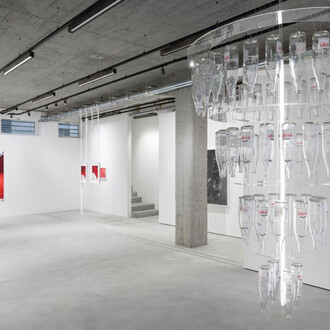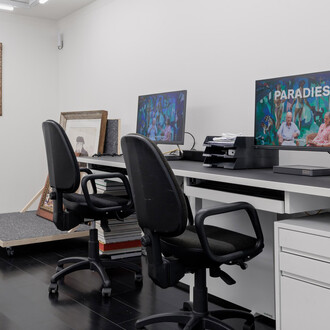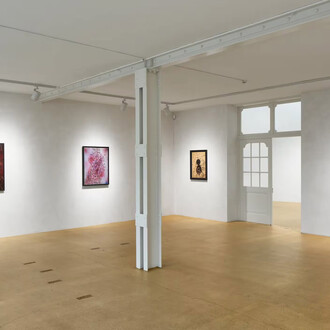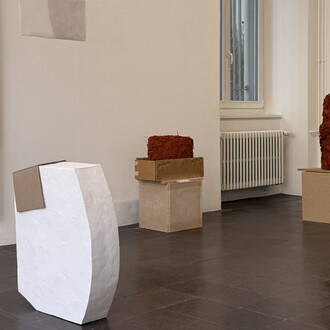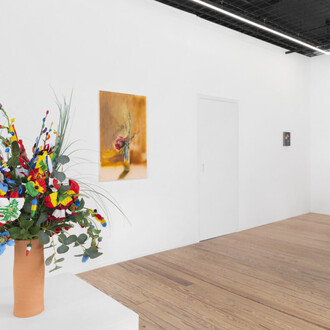The fact that the Zurich Concretist Max Bill (1908–1994) made a significant impression on the Brazilian art scene in 1951, both with his first major solo show at Museu de Arte de São Paulo and his participation in the first São Paulo Biennial, has already been touched on in several exhibitions at Museum Haus Konstruktiv. It is also documented that Brazilian artist Lygia Clark (1920–1988), one of the main representatives of the neoconcretismo movement that was initiated in 1959, made direct reference to Bill in the some of her works. To this day, the actual extent of Max Bill’s influence on the beginnings of concrete art in Brazil and the question of which other precursors played a role for neoconcretismo in particular are still subjects of art-historical discourse, which is incorporated into the exhibition at Haus Konstruktiv.
This exhibition was realised in close collaboration with Kunsthaus Zurich, to coincide with that institution’s retrospective Lygia Clark (14/11/2025 – 08/03/2026), curated by Cathérine Hug. Under the title Concrete art / Neoconcretismo – The work and impact of the Zurich concretists in Brazil, Haus Konstruktiv explores this Swiss-Brazilian connection. In a specially designed context space, a passageway leading to the parallel solo exhibition on Brazilian contemporary artist Artur Lescher, an illustrated chronicle summarises the key moments in the development of concrete art in Brazil. A space known as the glass box, in the passageway leading to Löwenbräu West, offers texts, images and film material, inviting visitors to delve deeper into the subject.
The main exhibition space focuses on Max Bill’s early works. Eleven of the eighteen pieces here were already shown in 1951, as part of his exhibition at Museu de Arte de São Paulo, and are labelled accordingly. Max Bill worked as an architect, painter, sculptor, graphic artist, designer and exhibition organiser. His commitment to promoting concrete art was particularly influential. He first formulated his theoretical approach in 1936 (pursuant to Theo van Doesburg’s text about the ‘Basis of Concrete Painting’) and continued to take it further in numerous writings, some of which were also published in Latin America. In 1927/1928, as a student at the Bauhaus, Max Bill had met Wassily Kandinsky, László Moholy-Nagy, Paul Klee and Josef Albers, thus receiving valuable impetus. From this, he developed his own artistic language, based on measure and order, embedded in a rationally comprehensible, systematically structured concept.
Bill’s artistic methodology is exemplified by his seminal graphic work quinze variations sur un même thème (1938): Its starting point is a spiral that emerges from a complex sequence of lines of equal length. These lines are arranged in such a way that various geometric shapes, such as an equilateral triangle, a square, a regular pentagon and others, harmoniously merge into one another. The resulting linear structure, enclosed by a regular octagon, is enhanced on the subsequent sheets by means of various techniques, such as the use of colour, the superimposition of circular elements, or the interconnection of the centres and corners.
One highlight of the 1951 exhibition was the sculpture dreiteilige einheit (tripartite unity, 1947/1948) – a sculpture cast in chrome-nickel steel, based on the principle of the endless loop, also known as the Möbius strip: a surface twisting into itself, whereby its inside and outside are indistinguishable from each other. Max Bill first explored this motif in 1935 and developed it further in numerous variations over the course of six decades. Also in this artwork, Bill demonstrates the mathematical approach that he considered essential to concrete art. “The characteristic feature of dreiteilige einheit,” as the artist himself put it, “is that it is constructed from a system of circles whose centres lie on the vertices of a Pythagorean triangle.” The work comprises three intertwined bands without beginning or end, which constantly open up new perspectives, depending on the viewing angle.
After the exhibition, dreiteilige einheit was purchased by Museu de Arte Moderna in São Paulo. At Museum Haus Konstruktiv, we are now showing a bronze version made in 1958, which we have received on loan from Galleria Nazionale d’Arte Moderna e Contemporanea in Rome.
Max Bill’s exhibition in Brazil came about at the invitation of Pietro Maria Bardi, an Italian, who was the first director of Museu de Arte de São Paulo (MASP), a museum founded in 1947. After exhibiting Alexander Calder (1948) and Le Corbusier (1949), Bardi wanted to present Bill as another important representative of modern art, architecture and industrial design. Alongside sculptures, prints and paintings, the exhibition also featured photo panels documenting Bill’s achievements as an architect, product designer, urban planner and exhibition designer, as well as his works in public spaces. Bill’s multidisciplinary oeuvre was well suited to the ethos of Instituto de Arte Contemporânea (IAC), founded in São Paulo in 1950, which was Brazil’s first design school to be modelled on the Bauhaus and was housed in the same building as MASP. This close connection was also evident in the manner in which the exhibition was set up: As the planning work for establishing the Ulm School of Design (HfG) meant that Bill could not travel to Brazil himself, Alexandre Wollner, one of the first IAC students, took charge of the exhibition’s implementation, based on a detailed sketch by Bill.
While the Bill exhibition received little attention from Brazilian art critics, it was met with great interest by numerous Brazilian artists. In particular, those who were already doing abstract geometric work, such as Waldemar Cordeiro, Geraldo de Barros and Mary Vieira, felt that the exhibition validated their artistic practice. Later, Mary Vieira, Alexandre Wollner and Almir Mavignier even decided to study at the Ulm School of Design, which started teaching in 1953.
Max Bill attracted more attention with his participation in the first Bienal de São Paulo, which opened in autumn 1951 at Museu d’Arte Moderna (MAM), founded in 1948. The plan was to show several of his works in the Swiss pavilion. In the end, Bill submitted only the sculpture dreiteilige einheit, which had previously been exhibited at Museu de Arte de São Paulo (MASP) and was now presented in the international sculpture section. With the support of Argentine jury member Jorge Romero Brest, as Bill’s ideas on concrete art had been circulating in Argentina since the mid-1940s, the work was awarded the Grand Prix for Sculpture. This recognition of dreiteilige einheit was celebrated by the contemporary press as a “milestone in the development of modern art in Brazil” and honoured as a “paradigm of geometric abstraction”. Concrete art was also present in the Swiss pavilion, with works by Richard Paul Lohse, Leo Leuppi and Sophie Taeuber-Arp.
Max Bill’s concept of modernism fell on fertile ground in Brazil, aided by social upheaval and a belief in progress. Since the 1920s, the country had been undergoing rapid urbanisation and industrialisation, which gained further momentum after 1945.
One important starting point for Brazilian modernism in art was the 1922 cultural festival Semana de arte moderna, at which artists from various disciplines championed independent Brazilian culture. It was in this context that Oswald de Andrade’s Manifesto antropófago was written in 1928, describing the appropriation of foreign (predominantly European) cultural influences via a symbolic act of ‘devouring’ (anthropophagy). The aim was to develop and promote independent Brazilian art and an independent Brazilian identity.
The project of cultural and social modernisation was also evident at the institutional level – for instance in the founding of new museums: Alongside the aforementioned Museu de Arte de São Paulo in 1947 and Museu de Arte Moderna in São Paulo in 1948, another notable example was Museu de Arte Moderna in Rio de Janeiro, which opened in the same year. Going beyond traditional exhibition practices, these museums offered platforms for innovative art mediation. The São Paulo Biennial also played a key role, opening people’s eyes to the international avant-garde with solo exhibitions on international artists such as Alexander Calder, Piet Mondrian, Paul Klee (all in 1953) and Sophie Taeuber-Arp (1955).
It is beyond dispute that Bill’s works provided considerable impetus for a modern language of forms. Even though there were already constructivist-concrete trends in Brazil, no specific groups of artists formed until after Max Bill’s exhibitions. In São Paulo, Grupo Ruptura was founded in 1952 (it would last until 1959). This group, like the definition of concretion set out by Theo van Doesburg and Max Bill, focused on objective and autonomous art that referred only to itself. In Rio de Janeiro, the loosely organised artists’ collective Grupo Frente followed in 1954 (it would eventually disperse in 1956). This group’s members included Lygia Clark. What set them apart from Grupo Ruptura’s strictly rational approach, was that intuition and individualism also played a role in their works.
The high point of concrete art in Brazil was the first Exposição nacional de arte concreta, initiated by both groups, which was held in São Paulo in 1956 and Rio de Janeiro in 1957. However, this exhibition also made differences between the respective artistic approaches clearly apparent. These led some former members of Grupo Frente, including Lygia Clark, to propose a reinterpretation of concrete art, which Ferreira Gullar formulated in the 1959 Manifesto neoconcreto and in his text Teoria do não-objeto (Theory of the non-object) from the same year. The neoconcretismo movement that had originated in Rio de Janeiro criticised groups of artists who were too markedly influenced by an objective, rational, European understanding of art. Without completely breaking away from concrete art (the geometric vocabulary of forms was still to be used) the neo-concretists rejected an overly scientific attitude and instead made expression the central factor: “By affirming the absolute integration of these elements [time, space, form and colour], neo-concrete art assumes that the ‘geometric’ vocabulary it uses is capable of expressing complex human realities.” Artworks were no longer just to be seen, but experienced with all the senses. Their art was geared towards active participation on the part of the observer. In keeping with the Manifesto antropófago, they wanted to break away from the dominant European cultural influences, in order to find their own modernity, in which Brazilian expression could manifest itself.
In 1953, Max Bill was invited by the Brazilian Ministry of Foreign Affairs to give a series of lectures in São Paulo and Rio de Janeiro. In his lecture Der architekt, architektur und gesellschaft (The architect, architecture and society) he sharply criticised Brazilian modernism, thus sparking a nationwide debate. Bill accused contemporary architecture of a tendency towards ornamentation and uselessness, and of neglecting its social function. His criticism was directed at Oscar Niemeyer in particular, whose curvaceous buildings he described as “excessive baroque” and “jungle growth in the worst sense”. In 1955, Niemeyer explicitly referred to Bill’s criticism in the magazine Moduló. He believed that Brazilian architecture lacked effective social anchoring, and that this was exacerbated by the absence of industrial construction methods using prefabricated components: “For these reasons, we refuse to resort to harsher and colder Europe-oriented architecture within our existing society, just as we reject ‘social architecture’.” Niemeyer sought a new plasticity with constructivist elements, rather than repetition of rigid geometries. As a result of his criticism, Bill was ultimately not invited to the biennial as a member of the architecture jury as planned, but instead as a member of the fine arts jury.
It is likely that Max Bill met Lygia Clark for the first time during his first trip to Brazil. That was when Clark, who had studied under Roberto Burle Marx and, in Paris, under Fernand Léger, began to explore the ‘organic line’ in her paintings. She no longer saw the picture frame as a boundary, but as an integral part of the composition. She incorporated it into the colour scheme, and used the gap between picture and frame as a connecting element, extending into the space.
Based on her understanding of the artwork as a body within the space, Clark developed her Bichos (Critters) series from 1960 onwards: moveable sculptures comprising geometric metal plates that are joined by hinges and can be manually altered by the observer. At Haus Konstruktiv, we are now showing an exhibition copy of these works, which invites visitors to move the object themselves.
In 1963, Clark turned her attention to the fascinating Möbius strip, years after having received the decisive impetus to do so: “It was Max Bill who, while staying in Brazil, showed me how to make a Möbius strip. That was my first big discovery. I spent countless nights exploring this phenomenon... Many years later, when traditional means of expression no longer satisfied me, I created Caminhando on the basis of the Möbius strip.”
The conceptual piece Caminhando (Walking, 1963), which can also be discovered at Haus Konstruktiv, consists of strips of paper, scissors, glue and instructions from the artist: Users are told to twist a white paper band into a Möbius strip and glue it together. In the next step, this strip is to be cut lengthwise with scissors until the starting point is reached again. At this point, the person performing the act must make a conscious decision: The cut can be continued either to the left or to the right of the original line. “The notion of choice is decisive – it is the whole point of this experiment. The creative work here is the mere act of doing.” This dismantles habits of perception and makes it possible to “experience a time without limits and within an endless space”.
Shortly afterwards, Clark created the series O dentro é o fora (The inside is the outside, 1963), Trepantes (Climbers, 1964) and Obra moles (Soft works, 1964), objects that are also based on the principle of the Möbius strip, but made of more flexible materials, such as thin metal or rubber, such that they can also be wrapped around stones, tree trunks or human bodies.
In Diálogo de mãos (Hand dialogue, 1966) an elastic bandage, twisted to form a Möbius strip, connects two wrists. The hands become the main protagonists in a participatory sculpture that only comes into being through this contact, through a shared sensory experience: The movement of the hands also moves the band and obliterates opposites such as inside and outside, right and left, top and bottom. Clark thus makes it possible to experience a dissolution of spatial boundaries. Unlike Max Bill’s concrete art, which strove for permanence and self-referentiality, Clark’s work is fleeting and experience-based. Diálogo de mãos thus marks an end to engagement with concrete art and a repositioning of Brazilian modernism in line with the Manifesto antropófago.










